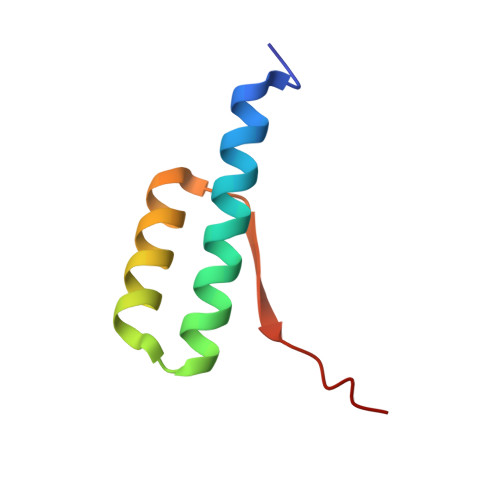Mechanistic insights into the homo-dimerization of HOIL-1L and SHARPIN.
Zhang, Y., Xu, X., Wang, Y., Wang, Y., Zhou, X., Pan, L.(2023) Biochem Biophys Res Commun 689: 149239-149239
- PubMed: 37976837
- DOI: https://doi.org/10.1016/j.bbrc.2023.149239
- Primary Citation of Related Structures:
8K6P, 8K6Q - PubMed Abstract:
HOIL-1L and SHARPIN are two essential regulatory subunits of the linear ubiquitin chain assembly complex (LUBAC), which is the only known E3 ligase complex generating linear ubiquitin chains. In addition to their LUBAC-dependent functions, HOIL-1L and SHARPIN alone play crucial roles in many LUBAC-independent cellular processes. Importantly, deficiency of HOIL-1L or SHARPIN leads to severe disorders in humans or mice. However, the mechanistic bases underlying the multi-functions of HOIL-1L and SHARPIN are still largely unknown. Here, we uncover that HOIL-1L and SHARPIN alone can form homo-dimers through their LTM motifs. We solve two crystal structures of the dimeric LTM motifs of HOIL-1L and SHARPIN, which not only elucidate the detailed molecular mechanism underpinning the dimer formations of HOIL-1L and SHARPIN, but also reveal a general mode shared by the LTM motifs of HOIL-1L and SHARPIN for forming homo-dimer or hetero-dimer. Furthermore, we elucidate that the polyglucosan body myopathy-associated HOIL-1L A18P mutation disturbs the structural folding of HOIL-1L LTM, and disrupts the dimer formation of HOIL-1L. In summary, our study provides mechanistic insights into the homo-dimerization of HOIL-1L and SHARPIN mediated by their LTM motifs, and expands our understandings of the multi-functions of HOIL-1L and SHARPIN as well as the etiology of relevant human disease caused by defective HOIL-1L.
Organizational Affiliation:
Department of Chemistry, College of Science, Shanghai University, Shanghai, 200444, China; State Key Laboratory of Chemical Biology, Shanghai Institute of Organic Chemistry, University of Chinese Academy of Sciences, Chinese Academy of Sciences, Shanghai, 200032, China.














